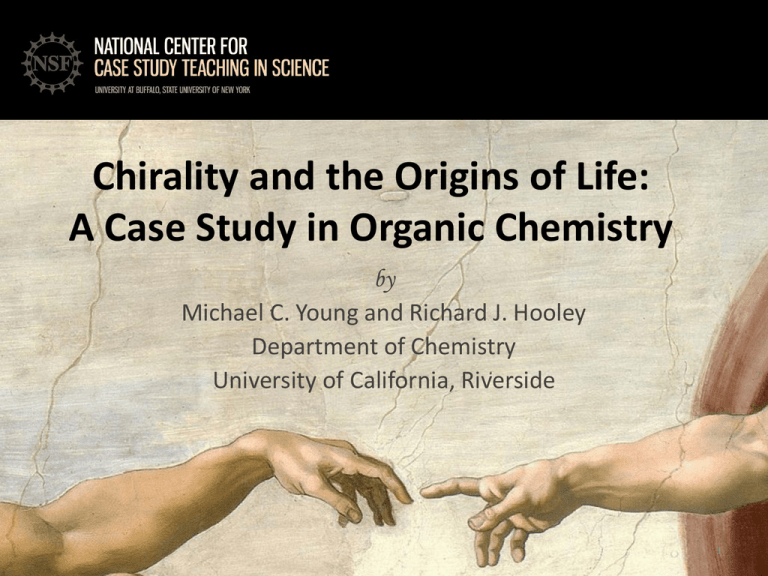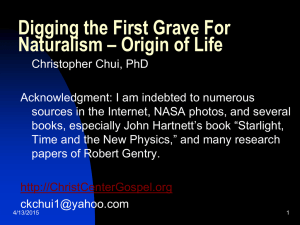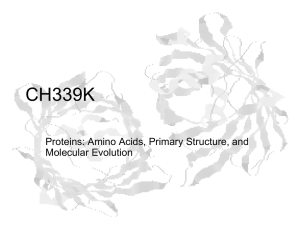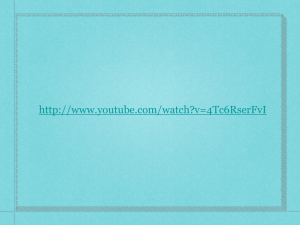Optional PowerPoint introduction to the case
advertisement

Chirality and the Origins of Life: A Case Study in Organic Chemistry by Michael C. Young and Richard J. Hooley Department of Chemistry University of California, Riverside 1 Case Scenario Carsten and Charles were having a philosophical discussion on the origins of life in the universe. Carsten had been reading some literature on the topic. This stated that the fact that amino acids are chiral, but naturally exist in only one form, means that evolution cannot be responsible for the initial formation of proteins and other building blocks of life. Charles disagreed with this, saying that the proportion of each form can alter over time—four billion years should be sufficient time for anything to occur. After a spirited debate, they decided to do some reading, and came across a paper in the Journal of the American Chemical Society by Noorduin, et al., that discussed their topic in more detail. 2 Background Natural amino acids form the basis for the structure of all proteins and enzymes in living organisms. The key to this is that each amino acid contains one stereocenter in its structure. All natural amino acids exist as a single enantiomer (the L isomer); this enantiomeric purity allows proteins (amino acid polymers) to form stable three dimensional structures. When determining how life on this planet began, the question of how enantiomerically pure amino acids were created from achiral building blocks is still a significant puzzle. A plausible "prebiotic” synthesis of amino acids is shown below, known as the Strecker reaction. While this addresses the issue of how amino acids could have originally formed, it does not address the chirality issue; achiral reactants always give a racemic mixture of products. 3 Amino Acids and Protein Biosynthesis mRNA being transcribed into protein by coding for specific amino acids attached to tRNA Proteinogenic amino acids common to all known organisms 4 Issues to Be Addressed Issues in the case: • How can the chirality of an amino acid surrogate be changed? • Under what conditions can enantiomeric excess be increased? • Is there a difference between enantio-enriching real amino acids and surrogates? • Could the original enantiomeric excess have come from outer space? Learning topics: • Acid-base chemistry of carbon-based acids and epimerization of stereocenters. • Le Chatelier's principle and solid state purification through Ostwald ripening. • Critical analysis of experimental data. 5 Part 1 – Amino Acids, Chirality, and Racemization a. Four natural amino acids are shown below. Determine the chiral centers in each amino acid and assign those centers R or S, according to the Cahn-Ingold-Prelog rules. b. In Noorduin, et al., amino acid surrogate 1 was used to illustrate enantiomeric enhancement upon crystallization. The first experiment was to illustrate racemization in solution upon treatment with added base, as shown below. Determine the position of the stereocenter in 1, and use the CahnIngold-Prelog rules to confirm the R/S stereochemistry. 6 Part 1 – Amino Acids, Chirality and Racemization c. DBU (1,8-diazabicycloundec-7-ene) is an organic amine base that can reversibly deprotonate 1. There are two lone pairs in DBU. Which is most basic? Draw the two protonated species, and see which one is most stabilized by resonance. d. Drawing DBU as B: (i.e. "base"), draw the mechanism for racemization of 1 upon treatment with base. Pay attention to the geometry of the charged intermediate. e. Why did Noorduin, et al., use the amino acid surrogate 1 instead of a natural amino acid? (HINT - what happens when you treat L-alanine with a base?) 7 Part 2 - Chirality Enhancement via Crystallization In this set, you will discuss the results of Noorduin, et al., and describe why the phenomenon is observed. a. The concept of the paper is shown below. Upon addition of a small excess of one enantiomer of 1 or a different chiral species (such as phenylglycine), crystals of 1 with 100% enantiomeric excess can be obtained over time. The key to this theory and experiment is selective crystallization. Based on your reading about Ostwald ripening, explain why a large crystal is more thermodynamically favorable than a small one. 8 Part 2 - Chirality Enhancement via Crystallization b) The experiment also relies on the fact that individual enantiomers crystallize together in a single crystal. Explain why this occurs - consider the solid state interaction of two molecules of the same handedness and different handedness. c) If there is only a small excess of one enantiomer in solution, can selective crystallization alone (i.e. in the absence of base) cause chirality enhancement? 9 Part 2 - Chirality Enhancement via Crystallization d. Discuss why the combination of added base (DBU in this case) and selective crystallization allows the enhancement of chirality of the system. Consider equilibrium effects and Le Chatelier's principle in your answer. e. This is a proof-of-principle experiment (i.e., it mimics the natural process, but several changes were made to allow study in a laboratory setting). To maximize the speed of the enhancement, glass beads and magnetic stirring were employed. How does this speed up the process? Is this a plausible method of mimicking natural evolution? Why did the researchers not simply perform the experiment as it would occur in prebiotic systems? 10 Part 3 – Critical Analysis You have discussed the results of Noorduin, et al. This is a controlled experiment designed to show the proof of principle that a slight excess of one enantiomer can lead to complete conversion to a single enantiomer over time, under the correct conditions. Here, in this question set, you will discuss whether this applies to prebiotic systems and is a good model for the origin of life. a. Is base-catalyzed racemization the most favorable acid-base reaction for natural amino acids? Determine the most acidic H atom in 1 and in L-alanine. Are they the same? 11 Part 3 – Critical Analysis b. This theory relies on crystallization. Are there large solid deposits of amino acids in nature? Are amino acids more or less soluble in water than 1? In question 2b you described why crystals of one enantiomer are more favorable than crystals of a racemic mixture. Is this always the case? c. Provide a critical analysis of this experiment. Discuss whether or not you believe the results of this experiment. Discuss whether this is a good "proof-of-principle" experiment, and whether it can apply to natural amino acids in a prebiotic environment. 12 Part 4 - Extraterrestrial Amino Acids So far, you have discussed chirality amplification. This theory still requires a small excess of one enantiomer to begin the amplification process. Here you will discuss how that original excess appeared. One (disputed) theory of the original genesis of "chiral molecules" on Earth comes from outer space. The Murchison meteorite, which fell to earth in Australia in 1969, was shown to contain traces of amino acids and other simple organic materials. These materials displayed a "slightly enhanced" enantiomeric ratio, i.e., more of one enantiomer than the other. The theory was posited that similarly chiral materials crashed to earth during the prebiotic period. (Note: There are a lot of scientifically dubious theories on this topic. We won't discuss how the enhanced chirality appeared on the meteor while in outer space; ask a physicist.) 13 Part 4 - Extraterrestrial Amino Acids a. The presence of natural amino acids with enantiomeric excess from the meteorite is still a subject of debate. Discuss why this is – what are the experimental issues with stating that alanine found on the Murchison meteorite has an excess of one (L) enantiomer? How might "false positives" be observed in the analysis of these meteorite samples? 14 Part 4 - Extraterrestrial Amino Acids b. An argument put forward to corroborate the meteorite theory is the presence of unnatural α-alkyl amino acids such as isovaline, which was observed to exist in the meteorite with a slight enhancement of the L isomer. Discuss why the observation of unnatural amino acids such as these is less susceptible to false positives than the presence of alanine above. c. Assume that there was an excess of (L)-isovaline on the Murchison meteorite. Discuss the plausibility of (L)-isovaline conferring chirality on species such as 1, based on your reading of Noorduin, et al. 15 Final Report Write a 2-3 page report on the case you discussed here, following the structure below. • Part 1: Provide the answers to the case study questions 1a-e at the start of your report. • Part 2: Critical Analysis Report: Using the answers to the case study questions 2-4, describe the major points of the case in essay format. Summarize the outcomes and concepts discussed in your lab session. Incorporate the answers to the case study questions 2-4 into your report essay - do not write separate individual answers. • Provide a short description of the outcomes of the experiment by Noorduin, et al. How does the experiment by Noorduin, et al., provide a “proof of principle” to the theory of chirality enhancement? • Provide a critical analysis of the experiment. Does this experiment provide the answer to our question (i.e., how did amino acids become 100% “L” from achiral starting materials)? Describe the positive and negative contributions of this paper to the theory. • In your conclusion, please address the final point from section 4. Noorduin’s paper suggests a reason for the enhancement of chirality from a small excess (1-2%) to complete asymmetry (100%). It does not address how that initial excess appeared in the first place. You have been given one theory about how chiral molecules appeared on earth--do you believe it? Are there weaknesses in that theory? This section is intended to be open-ended; points will be given for your analysis, not just whether your answer is "correct." (There is no proven answer to this question.) 16









